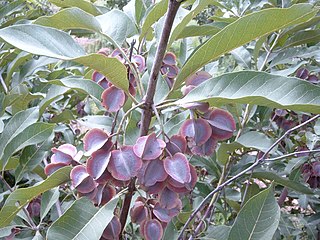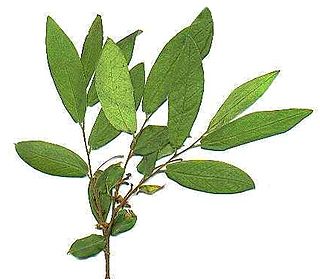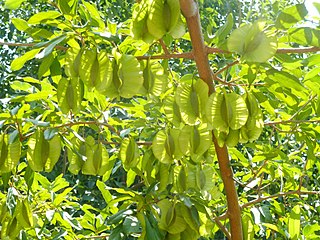
Combretum imberbe is a characteristic and often impressive bushwillow species of the southern Afrotropics. The medium to large tree has a sparse, semi-deciduous canopy of grey-green leaves. The twigs and leaves are hairless as the name imberbe suggests. Its heartwood is dark brown, close-grained, and very hard and heavy, as suggested by its vernacular name. The durable hardtwood is much sought after in the woodcarving industry. The Hereros and Ovambos of Namibia attach special cultural and religious significance to the tree, as to them it is the great ancestor of all animals and people, which must be passed with respect.

Combretum, the bushwillows or combretums, make up the type genus of the family Combretaceae. The genus comprises about 272 species of trees and shrubs, most of which are native to tropical and southern Africa, about 5 to Madagascar, but there are others that are native to tropical Asia, New Guinea and the Bismarck Archipelago, Australia, and tropical America. Though somewhat reminiscent of willows (Salix) in their habitus, they are not particularly close relatives of these.

Punicalagin (Pyuni-cala-jen) is an ellagitannin, a type of phenolic compound. It is found as alpha and beta isomers in pomegranates, Terminalia catappa, Terminalia myriocarpa, and in Combretum molle, the velvet bushwillow, a plant species found in South Africa. These three genera are all Myrtales and the last two are both Combretaceae.

Combretum afrum, commonly known as Cape bushwillow, is a species of tree native to South Africa. It is endemic to the Cape Provinces.

Combretastatin is a dihydrostilbenoid found in Combretum afrum.

Combretum edwardsii, the Natal combretum or forest climbing bushwillow, is an uncommon forest plant endemic to the mistbelt region of eastern South Africa. It has a climbing habit and the stems may often lie prostrate on the forest floor or on cliff tops. As with some other Combretum species the leaves assume autumn colours before they are shed. The plant flowers in spring and the 4-winged fruits reach maturity in late summer.

Cryptophycins are a family of macrolide molecules that are potent cytotoxins and have been studied for potential antiproliferative properties useful in developing chemotherapy. They are members of the depsipeptide family.

A mitotic inhibitor, microtubule inhibitor, or tubulin inhibitor, is a drug that inhibits mitosis, or cell division, and is used in treating cancer, gout, and nail fungus. These drugs disrupt microtubules, which are structures that pull the chromosomes apart when a cell divides. Mitotic inhibitors are used in cancer treatment, because cancer cells are able to grow through continuous division that eventually spread through the body (metastasize). Thus, cancer cells are more sensitive to inhibition of mitosis than normal cells. Mitotic inhibitors are also used in cytogenetics, where they stop cell division at a stage where chromosomes can be easily examined.

The white-bellied sunbird, also known as the white-breasted sunbird, is a species of bird in the family Nectariniidae. It is found in Angola, Botswana, Democratic Republic of the Congo, Eswatini, Malawi, Mozambique, Namibia, South Africa, Tanzania, Zambia, and Zimbabwe.

Combretastatin A-4 is a combretastatin and a stilbenoid. It can be isolated from Combretum afrum, the Eastern Cape South African bushwillow tree or in Combretum leprosum, the mofumbo, a species found in Brazil.

Combretastatin A-1 is a combretastatin and a stilbenoid. It can be found in Combretum afrum, the Eastern Cape South African Bushwillow tree.

Combretum kraussii, the forest bushwillow, is a medium-sized to large tree of eastern South Africa, Eswatini and southern Mozambique, which is found within, or in the vicinity of forests. The specific name commemorates Dr. F. Krauss who undertook a collecting trip to South Africa from 1838 to 1840.

Kinesin-like protein KIF11 is a molecular motor protein that is essential in mitosis. In humans it is coded for by the gene KIF11. Kinesin-like protein KIF11 is a member of the kinesin superfamily, which are nanomotors that move along microtubule tracks in the cell. Named from studies in the early days of discovery, it is also known as Kinesin-5, or as BimC, Eg5 or N-2, based on the founding members of this kinesin family.

Combretum molle, the velvet bushwillow, is a medium to large tree species in the genus Combretum found in western, eastern and southern Africa.
C. kraussii may refer to:

Dihydrostilbenoids (bibenzyls) are natural phenols formed from the dihydrostilbene (bibenzyl) backbone.

Combretum apiculatum is a species of tree in the family Combretaceae known by the common name red bushwillow. It is native to the mesic to semi-arid savanna regions of Africa, southwards of the equator.

Combretum mkuzense, commonly known as the Maputaland bushwillow, is a deciduous shrub or small tree that is native to a restricted area in the lowlands of eastern South Africa and southern Mozambique. It is similar in appearance to the large-fruited bushwillow.
Photostatins are inhibitors that can be switched on and off in vivo by visible light, to optically control microtubule dynamics. Photostatins are a form of photopharmacology.

Combretum zeyheri, the large-fruited bushwillow or Zeyher's bushwillow, is a species of flowering plant in the family Combretaceae, usually found growing on acidic or sandy soils in tropical African savannas. A small to medium-sized tree, its roots are used as a source of material for making baskets and as a traditional medicine for haemorrhoids.


















